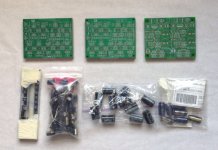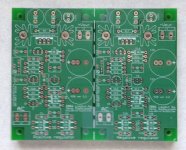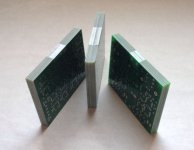You should still jumper the output back to the "-" input. Otherwise slight differences in the value of the 5k resistors might allow the output to swing all the way to a voltage rail because you have the op-amp in the open-loop mode.
Generally, you always close the loop on analog op-amp circuits in some fashion. There are exceptions but this wouldn't be one of them.
Cheers,
Dave.
Generally, you always close the loop on analog op-amp circuits in some fashion. There are exceptions but this wouldn't be one of them.
Cheers,
Dave.
Last edited:
Except get rid of that "lift leg" and make the connection to the + input. If you don't have 5K resistors don't sweat it anything from wire to 20K will do, and they don't need to match.
Edit: Davey's way makes sense.
Edit: Davey's way makes sense.
Bob,
Yeah, they do need to match.......IF the output is not going to be connected back to the "-" input. If you make that connection then it would be fine with unmatched resistors or wires.
Dave.
Yeah, they do need to match.......IF the output is not going to be connected back to the "-" input. If you make that connection then it would be fine with unmatched resistors or wires.
Dave.
Good point. I've always grounded the positive input and looped back output to negative input without an issue. Just a buffer without a signal. Hadn't looked at it in the more complex mode proposed.
Yep, that configuration is the simplest way to do it.
The objective here is to keep the output of that unused op-amp section locked exactly halfway between +V and -V applied. (Assuming you're using a bi-polar supply.) You don't want it wandering around in some indeterminate state by (possibly) differing offset currents created by slightly different value input resistors.
Off topic: Many op-amp circuits can be operated in the "open-loop" mode....but you don't usually see them in audio circuits. An example is a comparator. You want to do a simple sine-wave to square-wave conversion, it works great. 🙂
Cheers,
Dave.
The objective here is to keep the output of that unused op-amp section locked exactly halfway between +V and -V applied. (Assuming you're using a bi-polar supply.) You don't want it wandering around in some indeterminate state by (possibly) differing offset currents created by slightly different value input resistors.
Off topic: Many op-amp circuits can be operated in the "open-loop" mode....but you don't usually see them in audio circuits. An example is a comparator. You want to do a simple sine-wave to square-wave conversion, it works great. 🙂
Cheers,
Dave.
active filter 4 parts, boards etc 4-sale
Here is a project I have finally accepted that I will never get to, though I wanted to badly.
(13) active filter 4 boards
(6) PSU boards (each board includes the Pos and Neg side).
(50) OPA2134
(50) 470uF/25V
(10) 1000uF/35V
(11) 2200uF/100V
All parts, all new, pristine.
Not really sure what to charge for this but I would like to sell it all at once, so I guess bids???
Here is a project I have finally accepted that I will never get to, though I wanted to badly.
(13) active filter 4 boards
(6) PSU boards (each board includes the Pos and Neg side).
(50) OPA2134
(50) 470uF/25V
(10) 1000uF/35V
(11) 2200uF/100V
All parts, all new, pristine.
Not really sure what to charge for this but I would like to sell it all at once, so I guess bids???
Attachments
There is a quad, 4134 and it will perform much as an lf411.
The lf412 is virtually the same as the lf411
The lf412 is virtually the same as the lf411
Hi F1, poteph - Does anyone remember what the cost of the filter 4 boards group buy was?
I would be interested in splitting all this up if we get a few more buyers. I'll check into what a reasonable price is for the BB 2134PA are going for.
Stan
I would be interested in splitting all this up if we get a few more buyers. I'll check into what a reasonable price is for the BB 2134PA are going for.
Stan
The original group buy boards were very cheap because they were ordered in vast quantities, I think it was less than $5 per board IIRC. The group buy OPAs were cheap as well (I still have most of mine), again because the combined order was large (a few thousand pieces)
/U.
/U.
The original group buy boards were very cheap because they were ordered in vast quantities, I think it was less than $5 per board IIRC. The group buy OPAs were cheap as well (I still have most of mine), again because the combined order was large (a few thousand pieces)
/U.
OK, thanks we can split this package up if we can get orders for all the boards and hopefully opa2134's. It would be nice if I didn't have to piece meal all these out at different times so maybe a mini group buy here untill all sold unless moderators thot this might not be a good idea.
Boards - $5.00 each
BB OPA2134PA - 3.00 each.
Here is a link showing the cost of one 2134's at mouser for one:
Texas Instruments OPA2134PA Audio Amplifiers | Mouser
Attachments
Remember that each board can be configured as a high pass/ low pass or band pass for a single channel. F1 fan, your quantity of three had me wondering what you plan. Three 2 ways?
I will be happy to send the schematics, spreadsheet and build guide. Just PM me with your email address.
I will be happy to send the schematics, spreadsheet and build guide. Just PM me with your email address.
Thanks Bob,I was in on one of the earlier group buys so have the spreadsheet and schem's, these are mostly for future consideration.Not many options for good active filter boards especially at the price.
I have used the LP and LT sections of single boards for subwoofer duties thus the odd number.
I have used the LP and LT sections of single boards for subwoofer duties thus the odd number.
- Status
- Not open for further replies.
- Home
- Group Buys
- Active filter board GB





